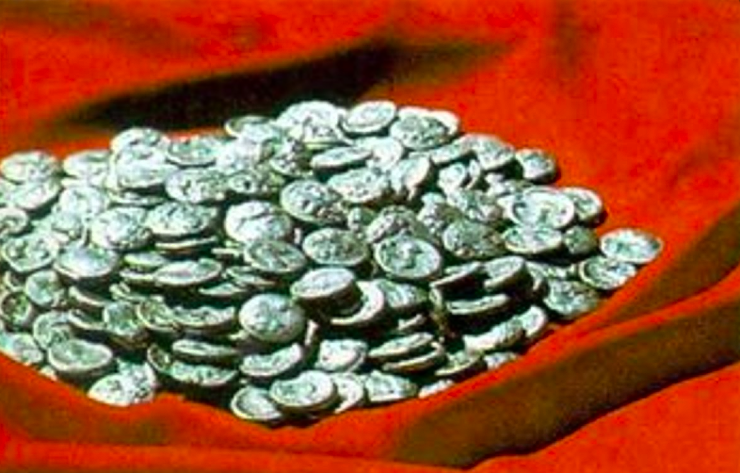Opět velmi pěkná informace. Díky za takové články.
10.5.1950 Celtic coins have been lying in the attic for 18 years
Categories: Finds and rescue research in the Czech Republic , Calendar

The vessel full of Celtic-Dacific coins was discovered in 1950 by Jozef Drabant when he was ploughing a field in the village of Ptičie. He hid the treasure in the attic, where it was found eighteen years later. 237 coins were saved. Drabant's son received 20 crowns for each piece. Some thought he had become a millionaire...
Drabant came across the coins while ploughing a field in Hrunoch, behind the village. His wife Anna was also there. "They were my husband's parents. During the ploughing, they suddenly broke something with the plough. They saw shards from an earthenware jar and something that looked like old coins. They were coarse pieces clogged with clay, which they brought home," said Anna Drabantová.
The treasure was hardly talked about at the Drabants' house. "All I knew was that they put the coins in a large glass jam bottle at home. The treasure had been in their attic for years," said Drabantová.
One day the director of the museum from Humenne came to them. He spread the coins on a table and counted them piece by piece. That was 1968. "Then he took them away and we never saw them again. People thought we had gotten rich on them. Meanwhile, my husband's parents had died. They had nothing of the treasure. My husband then got twenty crowns for each piece," Drabantová said.
According to Dr Eva Kolníková, a numismatist from the Institute of Archaeology of the Slovak Academy of Sciences, 237 coins were saved from the treasure. We were building a house, the money went there. Some people thought that we might have come into millions. But it wasn't so. We went to work like everyone else. We had to earn the money," Drabantová recalled.
Kolníková said in the documentation for the hoard that it is likely that not all the coins from the depot made it into the hands of archaeologists. Anna Darabantová, however, claims that they handed over everything. "I think only one coin was given by my husband to the doctor, but I don't remember exactly," the woman noted.
She said no one in the Drabant family even discussed what would have happened if they had kept the treasure. "Years ago, there were those who came to our village thinking they would find some treasure. They would ask us where the Hruna were, where exactly the coins were found. One gentleman even had some instruments in his car. But nobody seemed to have found anything," Drabantová added.
According to Mayor Marian Čorný, the discovery made the village more visible. "But for us it was important that the treasure proves the presence of Celts in our territory," he concluded.
Sources: www.sme.sk
The article is included in categories:
- Archive of articles > Archaeology > Finds and rescue research in the Czech Republic
- Archive of articles > Calendar
Post
Krásně napsané. Bohužel nálezce nedostal adekvátní odměnu. Tyto články jsou velice poučné.
Více info: PhDr. Ivana Strakošová
Vihorlatské múzeum v Humennom
Poklad tvoria strieborné mince, napodobeniny tetradrachiem Filipa II. Macedónskeho (359 – 336 pred Kr.).
Na averze je vyobrazenie vpravo obrátenej mužskej hlavy (Zeus) s bohatou bradou a fúzmi, na hlave je
vavrínový veniec. Okolo okraja mince je vyrazený perlovec. Vyobrazenie na averzoch nie je jednotné,
predstavuje razidlá rôznej kvality. Na reverze je vľavo obrátený klusajúci kôň s rôzne štylizovaný jazdcom.
Práve tento fakt spôsobuje rôznorodosť mincí zastúpených v náleze. Stvárnenie jazdca na koni, odlišné od
pôvodnej predlohy umožňuje rozlíšiť 9 typov. V ich rámci môžeme sledovať viacero variant, ktoré vznikli
pravdepodobne v dôsledku obnovovania razidla.
Mince sú zhotovené z dobrého striebra, ich hmotnosť sa pohybuje od 12,21 g do 14,89 g, veľkosť
mincovných kotúčikov od 2,12 do 2,60 cm, hrúbka od 0,4 do 0,6 cm. Vyobrazenie má zväčša vysoký reliéf.




